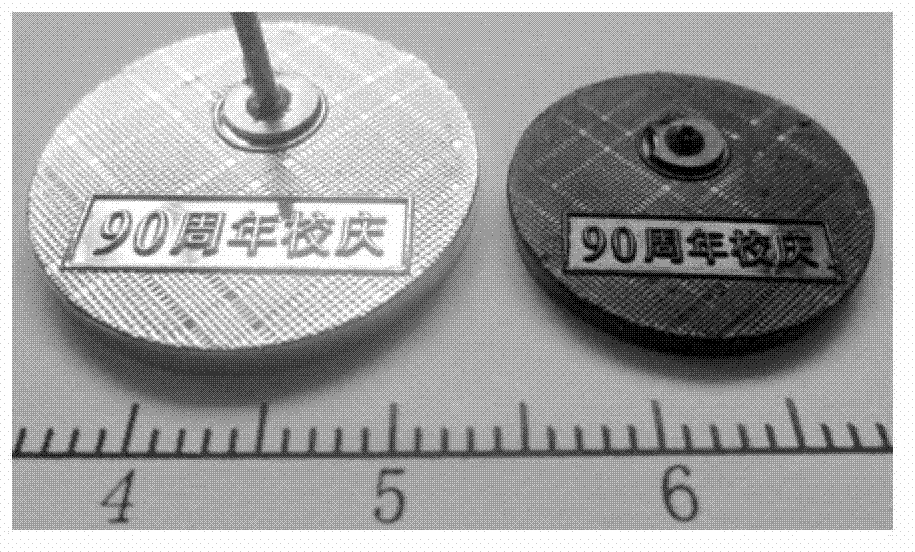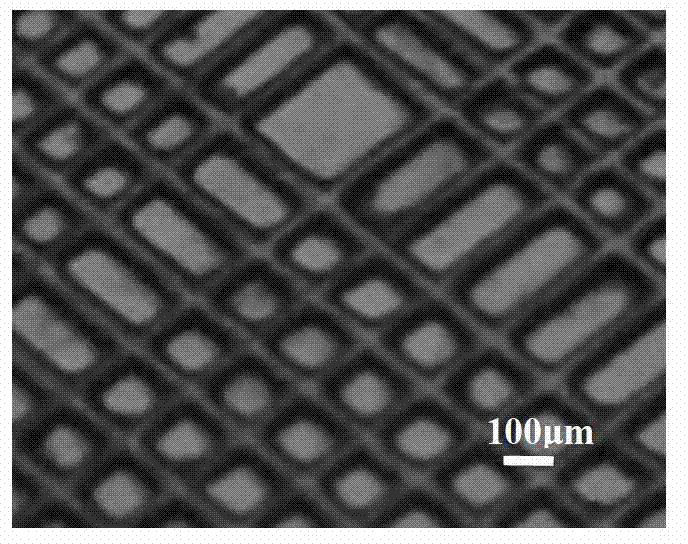Method of using ceramic precursors to prepare patterned ceramic
A ceramic precursor and patterning technology, applied in the field of patterned ceramics, can solve the problems of limited application, poor high temperature resistance of oxygen-containing ceramics, etc., and achieve the effect of wide application value and fine pattern
- Summary
- Abstract
- Description
- Claims
- Application Information
AI Technical Summary
Problems solved by technology
Method used
Image
Examples
Embodiment 1
[0018] Using a copper badge as a master mold (diameter 20mm, thickness 2mm), mix 5g polydimethylsiloxane (PDMS) and 0.5g crosslinking agent evenly. Take 1g of PDMS solution mixed evenly and drop it into a metal box 1.2 times the size of the master mold, ultrasonically remove air bubbles for 10 minutes, then place it in a 70°C oven for 15 minutes, then put the master mold into the metal box, and place it in the oven for 70 Continue heating at ℃ for 6h. After the PDMS is solidified, 1.5g of PDMS solution is added dropwise on it, ultrasonicated for 10min to remove air bubbles, and then placed in an oven at 70°C for 6h. After the PDMS is solidified, the master mold is separated to obtain a PDMS mold with a mold cavity in the shape of the master mold. Add 5% photoinitiator I819 to the liquid ceramic precursor polysilazane (PSN), stir magnetically at 110°C for 1 hour, stir evenly and inject it into the cavity of the PDMS mold, and then place it at 220mw / cm 2 Irradiate under the ul...
Embodiment 2
[0021] Still using a copper badge as the master mold (diameter 20mm, thickness 2mm), mix 5g of polydimethylsiloxane (PDMS) and 0.5g of cross-linking agent evenly. Take 1g of PDMS solution mixed evenly and drop it into a metal box 1.2 times the size of the master mold, ultrasonically remove air bubbles for 10 minutes, then place it in a 70°C oven for 15 minutes, then put the master mold into the metal box, and place it in the oven for 70 Continue heating at ℃ for 6h. After the PDMS is solidified, add 1.5g of PDMS dropwise on it, ultrasonicate for 10 minutes to remove air bubbles, and then place it in an oven and heat at 70°C for 6 hours. After the PDMS is solidified, the master mold is removed to obtain a PDMS mold with a badge pattern cavity. Add 5% thermal initiator DCP to the liquid precursor polysilazane (PSN), stir magnetically at 40°C for 1h, stir evenly, inject into the cavity of the PDMS mold, and then heat in an oven at 130°C for 6h to cure Finally, the PDMS mold was...
Embodiment 3
[0023] Using a steel coin as the master mold (diameter 25mm, thickness 2mm), mix 5g polydimethylsiloxane (PDMS) and 0.5g crosslinking agent evenly. Take 1.5g of the PDMS solution that has been mixed evenly and drop it into a metal box that is 1.2 times the size of the master mold, vacuumize to remove air bubbles, and then heat it in a 90°C oven for 5 minutes, then put the master mold into the metal box and place it in the oven Continue heating at 90°C for 20 minutes. After the PDMS is solidified, add 2g of PDMS dropwise on it, vacuumize to remove air bubbles, and then place it in an oven and heat at 50°C for 10h. After the PDMS is solidified, the master mold is peeled off to obtain a PDMS mold with a coin pattern cavity. Add 5% photoinitiator I819 to the liquid precursor polysilazane (PSN), stir magnetically at 110°C for 1 hour, stir evenly and inject it into the cavity of the PDMS mold, and then place it at 220mw / cm 2 Irradiated under a UV lamp for 15 minutes. After curing,...
PUM
| Property | Measurement | Unit |
|---|---|---|
| diameter | aaaaa | aaaaa |
| diameter | aaaaa | aaaaa |
| diameter | aaaaa | aaaaa |
Abstract
Description
Claims
Application Information
 Login to View More
Login to View More - R&D
- Intellectual Property
- Life Sciences
- Materials
- Tech Scout
- Unparalleled Data Quality
- Higher Quality Content
- 60% Fewer Hallucinations
Browse by: Latest US Patents, China's latest patents, Technical Efficacy Thesaurus, Application Domain, Technology Topic, Popular Technical Reports.
© 2025 PatSnap. All rights reserved.Legal|Privacy policy|Modern Slavery Act Transparency Statement|Sitemap|About US| Contact US: help@patsnap.com


